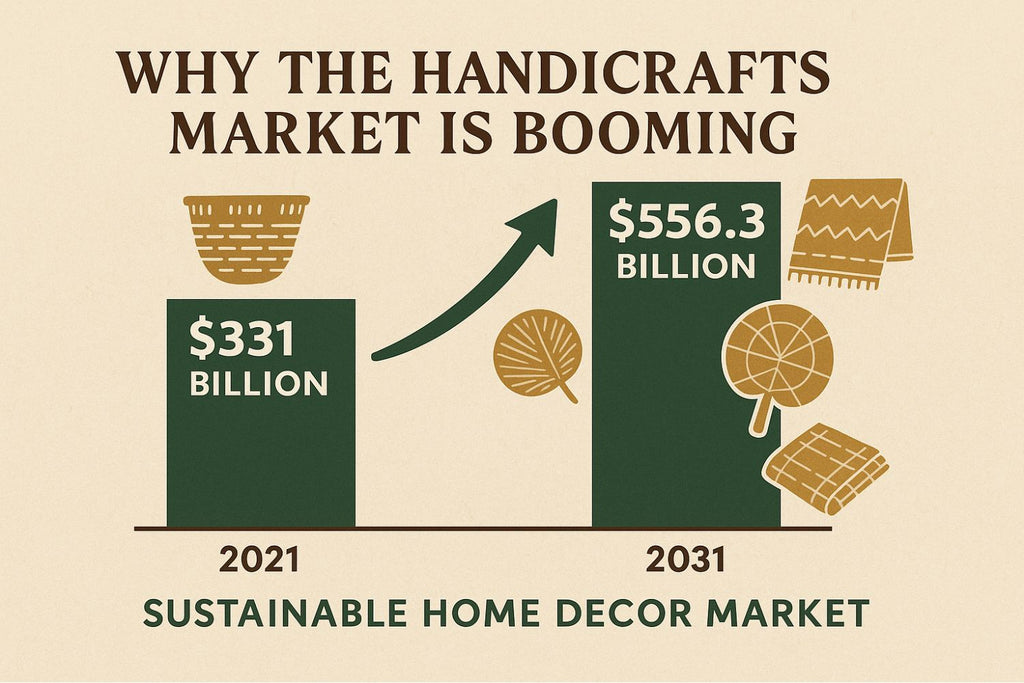Sustainable Home Decor Market to Hit $556 Billion by 2031

When I started Rufina Designs, I was simply following my love for beautiful, handmade African accessories—woven baskets, wall baskets, black dolls, straw fans, planter baskets, and more. Over time, though, I noticed more and more people began asking not just what I sell, but how it’s made, who made it, and what materials were used.
It turns out, there’s a reason for that shift. According to a report by Allied Market Research, the sustainable home decor market was valued at $331 billion in 2021, and it’s projected to reach a staggering $556.3 billion by 2031, growing steadily at around 5.3% each year (Global Insight Services, 2022).
This growth is driven by consumer demand, as more people seek eco-friendly and ethically produced products. Urbanization is also a factor; as cities expand, there is a greater emphasis on sustainable living. And the rise of online retail and e-commerce has made sustainable products more accessible.
It shows that the world is waking up to what many of us have believed for a long time: decorating your home shouldn’t cost the earth.
Why shoppers are rethinking their decor choices
One big reason behind this surge is that consumers are getting serious about sustainability. A survey from Nielsen found that 81% of global consumers now feel strongly that businesses should be helping to improve the environment. Even more telling, 73% said they’re willing to change their consumption habits to reduce their environmental impact (Nielsen, 2022).
In my own small way, I see this play out when my customer asks where my baskets are woven, who makes them, and what materials are used.
For many shoppers, sustainable home decor means supporting local artisans, using natural fibres, and choosing recycled or low-impact materials. When I source baskets or planters, I think carefully about this — about working with artisans who use straw, sisal, and other natural, sustainable resources.
What "sustainable" really means in home decor

When I source materials for my woven baskets and planters, sustainability guides every decision.
But across the industry, "sustainable home decor" encompasses various approaches like working with local artisans who create handmade products, sourcing natural, renewable materials, using recycled or upcycled components, creating products with minimal environmental footprint, and ensuring fair wages and safe working conditions for makers.
In fact, sustainable furniture, textiles, and floor coverings are now finding their way into offices, hotels, restaurants, outdoor spaces, and even libraries (KBV Research, 2025). It’s no longer limited to "eco-warriors." Big brands and hospitality groups are embracing sustainability, too, because customers expect it.
And in the United Kingdom, the home décor segment is expected to generate $4.59 billion in 2025, with a modest growth rate of 1.46% annually from 2025 to 2029 ( Statista UK, 2025 ). Although the growth might seem slow compared to global figures, there's a clear surge in demand for sustainable and ethically made home decor items in Britain, too.
Based on the data, floor coverings are taking the largest slice of the sustainable decor market. Urbanisation, rising incomes, and a growing passion for home improvements are fuelling demand for sustainable rugs, mats, and carpets.
Furniture and home textiles made from recycled and natural fibres are close behind. And it’s not surprising. Eco-friendly sofas, curtains, and cushions feel like a natural, caring choice for modern living.
For example, at Rufina Designs, our wall baskets and straw fans often use materials like elephant grass and raffia, sustainably harvested and dyed with plant-based colours. Customers are drawn to these handmade touches because they blend beauty with purpose
Why this growth matters for shoppers and businesses
If you’re shopping for home accessories, it means you have more choices than ever to decorate your home responsibly — and not at the cost of style. From recycled textiles to ethically sourced wooden furniture, sustainable options are becoming mainstream.
Your purchasing decisions directly support environmental conservation through sustainable material use, fair wages for artisans and makers worldwide, and reduced carbon footprints.
For my fellow small business owners in the home decor space, this growth signals that sustainable practices aren't just the right thing to do—they're increasingly good business. Consumers are actively seeking products that align with their values, and they're willing to pay for quality items with transparent, ethical origins.
It’s a call to stay true to ethical sourcing, work with local communities, and keep sustainability at the heart of what we do.
It also highlights why collaborations with skilled artisans are so important. Brands that work directly with craftspeople — paying fair wages, preserving traditional skills, and choosing sustainable materials — are doing the right thing. They’re positioning themselves for long-term success.
Final thought

The projected growth of the sustainable home decor market is a positive sign that consumers and businesses alike are embracing sustainability.
As we head forward, the businesses that will thrive are the ones that combine beauty with responsibility. I’m proud that Rufina Designs is part of that movement and offers products that reflect these values.
Whether you're a designer looking to incorporate sustainable pieces into your work or a shopper seeking meaningful decor, the future looks bright for sustainable home decor.





